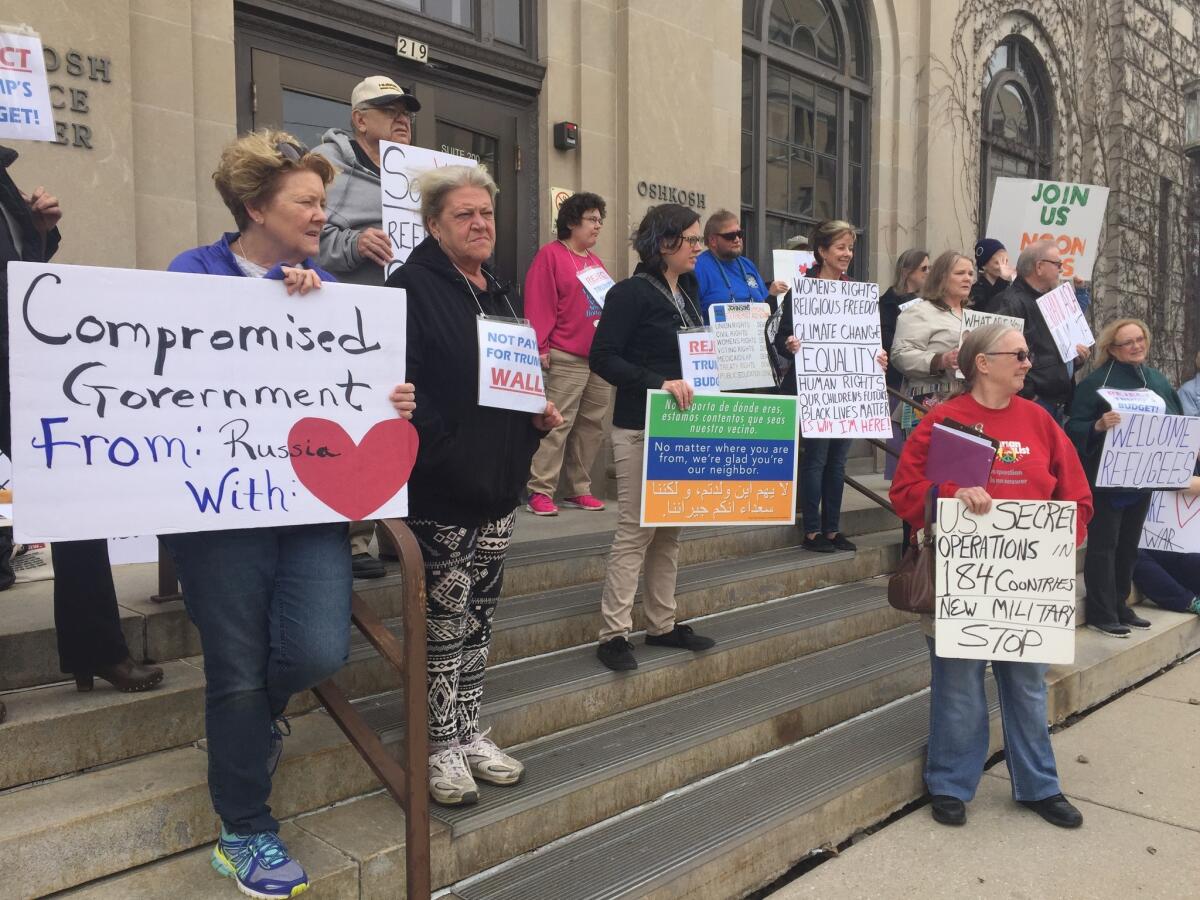Trump’s election has mobilized a resistance like no other, but will Democrats’ answer to the tea party divide the ranks?

- Share via
Reporting from Oshkosh, Wis. — She knew to hold her tongue during a business trip to Chicago the night Donald Trump was elected, and endured a long evening of schmoozing with the other sales reps and executives.
Back in her hotel room the next morning, Lisa drew a hot bath and sobbed.
Then her sadness turned to an anger that startled even her. The 55-year-old mom, never particularly active in politics, went outside, looked up at the nearby Trump Tower office building and flipped the icon of the new president the double bird.
From that point, there was no turning back. Within days she had organized a Trump resistance group, donned a pink pussyhat and drove 14 hours with a carload of like-minded crusaders to the Women’s March in Washington.
“We’re all terrified at what’s going on — that our country is going to be somehow ruined,” said Lisa, who kick-started early retirement to focus almost full time on civic activism. Even so, she’s reluctant to allow her full name to be used, worried about how her efforts could affect her life and her family.
President Trump’s election has mobilized thousands of first-time activists in a do-it-yourself movement like nothing seen on the political left in years. With bountiful energy and some impressive early successes, the grass-roots movement has stunned even Democratic Party officials, drawing comparisons to the tea party movement that transformed the GOP with its unyielding opposition after President Obama’s election.
Women nationwide — and much of the movement is being fueled by women — are organizing via Facebook, email and often tearful support meetings around kitchen tables.
The Indivisible Project, launched after Trump’s election, has already sprouted nearly 6,000 chapters nationwide, at least two in each of the 435 congressional districts.
More established activist groups like MoveOn.org — which holds weekly “Resist Trump Tuesdays” protests — are enjoying a surge in membership, particularly in blue states, but most surprisingly in some deep-red pockets, where liberals had largely kept quieter. One Colorado activist said that in past years, event turnout rarely matched the number of advance sign-ups; now it routinely surpasses it.
These newly minted activists — along with other long-standing protest groups on the left — flooded the U.S. Capitol switchboard during Senate confirmation hearings for Trump’s Cabinet, pushed Democrats to filibuster Neil M. Gorsuch’s Supreme Court nomination and helped tank the president’s plan to repeal and replace the Affordable Care Act — often by noisily protesting at lawmakers’ town hall meetings.
With old-school organizing and modern-day social media they have formed instant communities that can mobilize hundreds — even thousands — as a group of stay-at-home moms in Kenosha, Wis., did recently to protest Trump’s visit there.
“We always told our kids there’s a lot of really smart people in our country, and we all want to make it better,” said Julia Kozel, one of the women who organized the Kenosha rally. “But I don’t feel like I could say that anymore.”

Like the tea party activists before them, many of the resisters — as they call themselves — are newcomers to the political process. And much in the same way tea party activists grieved for the country they no longer recognized under Obama, these women recount being devastated that fellow Americans elected Trump and say they are fighting to restore their own vision of the country.
Publicly, Democratic officials embrace the newfound energy on the left. Party strategists even marvel at the large turnouts that they had been unable to achieve in recent years.
But privately, many Democrats also worry the movement is whipping up a deep-rooted emotional and ideological fervor, much like the tea party did in blocking Obama’s agenda. Unpredictable and with no clear leadership, the liberal uprising could prove difficult to contain and may turn its anger — currently focused on Trump — toward the Democratic Party itself, just as the tea party fractured the GOP.
Wounds from the 2016 primary battle between former Secretary of State Hillary Clinton and Sen. Bernie Sanders of Vermont still run deep among Democrats, and the protest movement could split the party further between moderates and progressives.
Even Sen. Elizabeth Warren (D-Mass.), a favorite among progressives, found herself under fire after voting to confirm Housing Secretary Ben Carson. Some progressives threatened to challenge the Massachusetts liberal in the next primary.
California Democratic Sen. Dianne Feinstein felt pressured enough to hold her first town hall in years early this month. There she was heckled as a “sellout” from an occasionally rowdy crowd of liberals.
When airport protests erupted over Trump’s first travel ban, Sen. Cory Booker (D-N.J.) raced to Dulles International Airport to demonstrate his solidarity.
“No party is safe,” said Jeanne Peters, a jewelry designer in West Virginia, whose Indivisible chapter has started calling its House member and both its Republican and Democratic senator every weekday with a coordinated message, such as demanding a congressional vote on Syrian airstrikes or opposing the GOP healthcare plan.
If the threat from the left wasn’t evident enough, a new political action committee, #WeWillRreplaceYou, is raising money to back primary campaigns against Democrats they view as insufficiently progressive — much the way outside conservative groups targeted “RINOs,” politicians they considered Republicans in Name Only.
Voters who are “fed up with the Democratic Party at every level want to see their Democratic representatives stand up and fight Trump,” said Claire Sandberg, a former Sanders organizer who is a cofounder of the PAC.
Another group run by former Sanders allies, Brand New Congress, is recruiting challengers for every single House district — Democrats and Republicans alike — in 2018.
Rep. Ted Lieu, a progressive from Torrance known even in Oshkosh for his pointed tweets about the president, acknowledged the risk for Democrats as passions run like nothing he has ever seen.
“People call my office all the time, and they want President Trump impeached two months ago,” he said. “We just have to tamp down expectations.”
The groups make it no secret that they are using the tea party playbook to fight Trump.
“The tea party had a method of organizing that works,” said Hillary Shields, 32, a paralegal whose Indivisible group drew nearly 150 to a Saturday spring training for activists in Kansas City, Mo. “Why reinvent the wheel?”
Ezra Levin, a former Capitol Hill staffer who is president of the Indivisible Project, helped fuel the movement by posting online a how-to organizing guide that borrows heavily from the tea party. “The goal of this tactic isn’t just to target Republicans. It’s to stiffen the spines of Democrats,” he said.
But while the resistance groups share many similarities with the tea party, it remains to be seen how far they are willing to go to block Trump’s agenda. Would they be willing to shut down the government, as the tea party did over Obamacare, for their own priorities — say, to save Planned Parenthood or stop Trump’s travel ban?
The moms sitting around the dining room table at Kozel’s house the day after the Kenosha protest shake their heads no, saying they wouldn’t want to disrupt government operations or break laws with civil disobedience.
“Our endgame is getting people elected,” said Kozel, as three of her school-age kids munched doughnuts and played nearby.
But others know playing nicely may only go so far. Many women said that the Democratic Party needs to be more progressive — and they are trying to push the party in that direction.
Among the new activists is Lisa E. Hansen, 51, a former graphic artist who had never been politically active much beyond casting her vote.
“And then the election happened,” said Hansen, after she and others wrote postcards to lawmakers at her Oshkosh home.
She said she sunk into a depression, spending her days scouring the news to make sense of it all. Only when protesters turned out for the Women’s March did she think to herself: “I can do that.”

Now every Tuesday, Hansen, who is partly disabled by Lyme disease, puts her walker in the trunk of her family’s car and heads to downtown Oshkosh to Republican Sen. Ron Johnson’s office, where a few dozen resisters have been protesting every week since the inauguration.
She dials up the senator’s office on Mondays to say that her group is coming and would like a meeting.
The senator has not agreed to meet with them. But his staff comes out to hear their concerns, and sometimes Hansen brings them snacks.
On a recent Tuesday, more than two dozen protesters quietly formed a neat line outside the office with homemade signs reading, “Not paying for Trump’s wall!” and “Don’t let Wisconsin values be Trump’d.”
The Tuesday protests were supposed to last only for the first 100 days of the new administration. But as that date approaches, no one wants to quit, so they agreed to extend it for another 100 days.
“It’s given me a sense of purpose,” Hansen said. “Maybe we should send Donald Trump a thank-you note. He brought all of us together.”
Twitter: @LisaMascaro
ALSO
Analysis: Republicans face a Trump problem as they look to 2018 contests
‘Science is real,’ marchers in nation’s capital and worldwide declare
Trump is trying to repeal Obamacare again, but he still doesn’t have the votes
More to Read
Get the L.A. Times Politics newsletter
Deeply reported insights into legislation, politics and policy from Sacramento, Washington and beyond. In your inbox twice per week.
You may occasionally receive promotional content from the Los Angeles Times.











